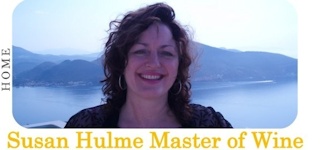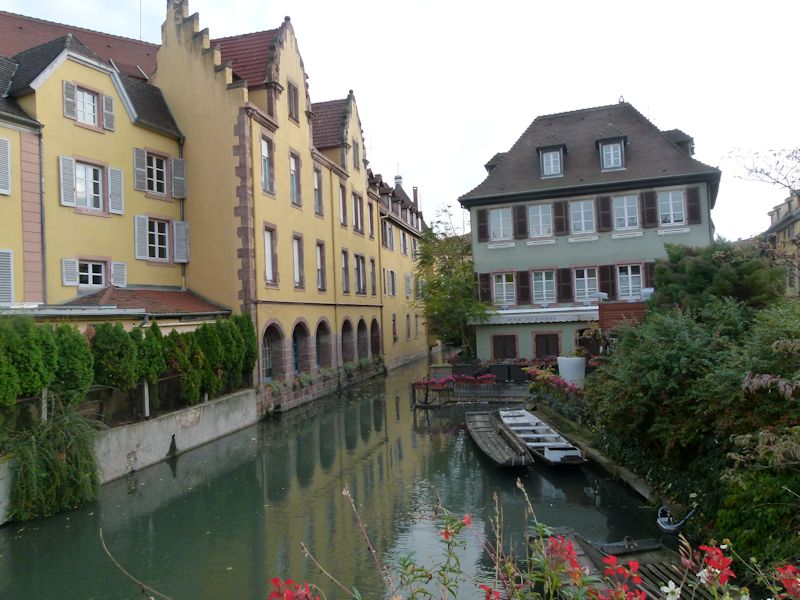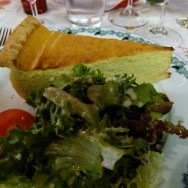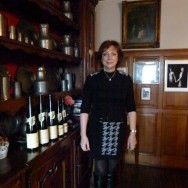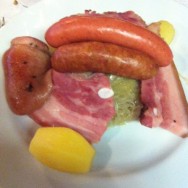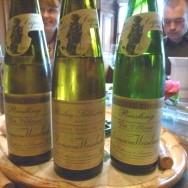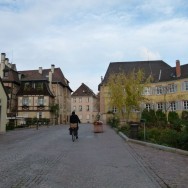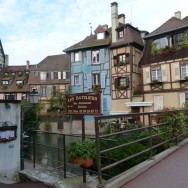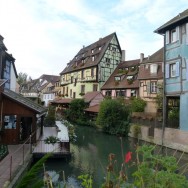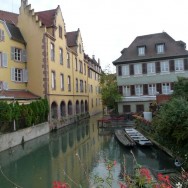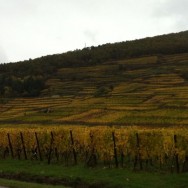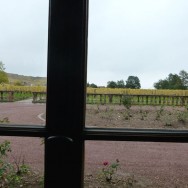Domaine Weinbach Faller is a powerful name in Alsace. They are one of a handful of producers at the top of their game and they produce some of the very best examples of Alsace’s distinctive style of Gewürztraminer. When I first heard of them, many years ago, they stood out for a few reasons; they made exceptional wines, they had two names and they were run by three women.
Alsace is a fascinating region in the far north-east corner of France. It is almost a little kingdom in its own right as it is cut off from the rest of France to the west by the Vosges Mountains and on the east it is separated from Germany by the River Rhine. Alsace is special for a number of reasons: although it is so far north, it is drier and sunnier than most other parts of France because it is protected by the Vosges; the upheaval when these mountains were created has resulted in a patchwork of different soils and sub-soils from several geological eras; the area specialises in distinctive
single grape varieties such as Riesling and Gewürztraminer. As if that weren’t enough to set Alsace apart, the wines are varietally-labelled and sold in distinctive tall bottles known as ‘Flutes’. Apart from dry wines, Alsace is famous for its Vendange(s) Tardive(s) (VT), which are late-harvested wines, and its Selection de Grains Nobles or (SGN) which are sweet wines affected by noble rot.
More on the wines later. As for the two names, Weinbach in local Alsace dialect means “Wine Brook”, and refers to a little stream that flows through the wine estate, while Faller is the family name. Domaine Weinbach was founded by Capucin monks in 1612 but In 1898 it was bought by two Faller brothers (our hostess, Catherine Faller’s grandfather and his brother) and it became known as Domaine Weinbach Faller. The estate was later inherited by Théo Faller, Catherine’s father, who died in 1979, leaving his wife Colette, and their two daughters, Catherine and Laurence in charge. Hence Domaine Weinbach Faller came to be run by three women. Laurence
Faller was the winemaker until 2010 when she left to move to Germany with her husband and two young children while Catherine was in charge of the business. Recently Catherine’s son Théo has been taking care of the vineyards, thereby keeping things in the family.
The day of our visit started with a fine grey drizzle and swirling mists but in spite of the weather the golden and russet colours of the vines in mid- autumn set the steep slopes of the undulating vineyards ablaze. The Faller home where our visit took place is surrounded by the original 9th Century monastic vineyard, the Clos (meaning walled vineyard) du Capucin and all of the estate’s wines are now labelled with this name. As an interesting aside, the colour of the habit worn by the Capucin monks is where the word cappuccino comes from.
We arrived at the famous walled vineyard and suddenly things fell into place and made sense. What had been a little traditional looking neck label with the words Clos de Capucin on Domaine Weinbach Faller wines now resonated with a sense of history and place.
Immediately behind the walled vineyards, across a small road, rose the green and gold-leaved slopes of the Schlossberg Grand Cru, one of Alsace’s 51 famous named vineyard sites or Grand Crus. In the hands of the right producer these Grand Crus represent some of the greatest expressions of terroir in Alsace. Not only that, but single varietal wines made from Alsace’s leading grape varieties, in particular Riesling, are like holding up a mirror to the terroir because of the clarity and focus with which they reflect the soils on which they are grown.
This was an exceptional tasting, partly because of the cosy informality of the setting in the Faller’s family dining room, partly because of the warmth of our hostess, Catherine, but most of all, because of the crystalline purity and laser-like clarity of the wines themselves. They were put before us like a set of shimmering peridot and yellow topaz jewels beguiling in their vivacity and brightness, as each revealed a little snapshot of their own particular soil & vineyard. Perhaps a key factor in the purity of these wines is the fact that Domaine Faller have been biodynamic since 1998 and certified by Demeter since 2010.
Catherine told us that they make over 20 different wines or cuvées and that the current 2011 vintage could be characterised as ‘juicy’. Through the dining room window we could see the famous Clos de Capucin and the first two wines were made from grapes grown there. Throughout the tasting, Catherine proved to be very enthusiastic and forthcoming with suggestions for food and wine pairings, even going into some detail with her own recipe for a truffle sandwich.
- Alsace onion tart
- Catherine Faller
- Choucroute garnie
- Clos des Capucin wines
- Colmar
- Colmar
- Colmar
- Colmar
- Domaine Weinbach Faller – Grand Cru Schlossberg
- Domaine Weinbach Faller – view of Clos des Capucin
Our first wine of the tasting was a Pinot Blanc Reserve 2011, a blend of 70% Auxerrois and 30% Pinot Blanc. This was followed by two different Pinot Noirs. All three wines were well made and attractive. Catherine suggested the first wine would be good with Alsace onion tart, or goats cheese dishes or chicken.
We then moved on to some of the real stars of the tasting, the young Rieslings.
Riesling Cuvée Théo 2011 from Clos des Capucin. This wine is made with low yields of 35 hl/ ha (equivalent to Grand Cru Burgundy yields). This had pure crystal clear aromas of flowers and lime zest. On the palate it was focused and long, with bright, ripe lime flavours, juicy acidity and not even a hint of bitterness. Vivid, focused and delightful. A little shy at present as it is very young now but will age for 10 – 20 years. 95/100
Riesling Cuvée Théo 2010. Very low average yield 22 hl/ha. Bright golden toned. On the nose it was just beginning to get classic Riesling notes of oil, & petrol followed by cream, wax, lanolin aromas on standing. Very concentrated and long on the palate with a saline/minerally finish. 94
Riesling Grand Cru Schlossberg 2011. Lovely honey and white peach fragrance with honey, peach, flowers & lime flavours. On the palate it had a softness mellowed by ripe yellow fruit flavours but balanced by a backbone of feisty acidity. This wine is made from the 8ha the Fallers own of the Schlossberg Grand Cru site which could be seen in the distance behind the Clos Capucin. This Grand Cru site has granite soil, very rich in minerals such as magnesium, and produces very fruity wines. All of their wines are vinified in large, old oak vats with temperature control. 94
At this point Catherine made two very pertinent remarks first that their wines were made with with “minimum intervention but constant attention” and that “Riesling is like a diamond which is polished by the terroir.”
Riesling Cuvée Sainte Catherine 2010. 30% of the grapes for this wine comes from the Schlossberg Grand Cru. Pale peridot colour. Very precise clear aromas of lime juice and petrol. Very, pure and focused on the palate with vivid acidity, creamy, minerally flavours and long, long finish. Crystalline in its focus and definition. 95
Riesling Grand Cru Schlossberg Cuvée Sainte Catherine 2010. Lime oil, bees wax and peach aromas. Bone dry with very lively but ripe acidity and a long creamy, minerally finish. This wine like many at this tasting was still very young and could last 10-12 years. 95
Next came two Rieslings from the Inedit! range. This is a special wine made from 60 year old vines and from the mid-section of the slope. They use some botrytised grapes in the blend. The wines are not produced every year. Asked to characterise the Inedit! style I would say these wines are “silky textured with flavours of very ripe fruit”.
Riesling Grand Cru Schlossberg Cuvée Sainte Catherine Inedit! 2011. This wine had a potential alcohol of 15% but fermentation was stopped at 14% leaving a residual sugar of 22 g/l r/s. Pale lemon topaz. Nose of white peach, lime and some oily notes becoming herbal on standing. It has a rich off-dry impression on the palate, interwoven with smoky, Lapsang souchong tea flavours, exotic spice and ginger. It finishes dry, and is a bit like a cross between Riesling and a very focused Gewürztraminer in its range of exotic spice flavours. 95
With this wine Catherine suggested a dish they had tried at home – lobster,
vanilla, & touch of lime.
They didn’t produce Inedit! in 2010.
Riesling Grand Cru Schlossberg Cuvée Sainte Catherine Inedit! 2009. 18 grammes residual sugar (r/s). Creamy, round medium dry impression, with a core of zesty lime and ginger flavours running through it. Very focused with a Long finish. Lovely racy acidity. 95
Pinot Gris Cuvée Sainte Catherine 2010. 15 g/l r/s. Pale gold colour with ginger, spice, slight earthy aromas. On the palate, a sweet initial impression with broad, round, honeyed flavours interlaced with smoke, ginger and spice. Catherine says it gains truffle-like flavours as it matures. I found the slight earthiness off-putting but it was an exotic wine. 92+
Suggested food matches were risotto with porcini/dried mushrooms, duck or veal. I could imagine this going well with Chinese crispy duck with exotic five spice and star anise or some other curried or spicy dishes.
Catherine enthusiastically suggested another match – her special recipe for truffle sandwich. It is important to use salted butter, leave the sandwich in the fridge for 36 hours for the flavours to meld together, then heat the bread for a few minutes before serving.
Pinot Gris Altembourg 2010. The soils are a combination of sandstone, limestone and marl. 30 g/l r/s but with more acidity. Slightly earthy, honeyed, oily, heady, nose. Rich sweeter, impression on palate but more noticeable, lively acidity, better balanced overall lively, fresh. Very spicy, gingery, long. 93
Apart from their stunning dry Rieslings, the Fallers produce some of the best Gewürztraminers in the world so it was interesting to hear Catherine’s views on this variety. They don’t produce really dry Gewürztraminers because as a white variety it has quite a lot of tannins, so they like 10 g r/s to counteract any phenolic bitterness. Another tip is that they never de-stem when they harvest as that would generate oxidation. Another interesting thing Catherine said was that with Gewürztraminer you don’t need to concentrate the flavours. True to this belief their wines were not at all overblown or exaggerated the way Gewürztraminer can be sometimes but at the same time they were rich and concentrated, yet limpid, pure and incisive too.
Gewürztraminer Cuvée Théo 2010. Bright yellow gold. Very delicate, pure precise rose petals and gentle honey aromas. Beautifully balanced creamy, soft, honeyed, rose petal, little ginger, subtle elegant & poised. Really delightful, beautiful texture, silky with delicate aromatics, like rose-decorated fine bone china 95 +
Gewürztraminer Cuvée Laurence 2009. This had softer, more mellow, honeyed aromas. Sweeter impression, rounder, ginger spice & yellow fruits, less intense and incisive, but more curvaceous and sumptuous. 95
Suggested food match from Catherine was sautéed goose liver & kumquats.
Gewürztraminer Altenbourg 2010. This Gewürztraminer was in a more nervy and steely style, with a small thread of lime peel flavours. Sweet initially but very lively with more noticeable freshness and focus. Lighter touch. 95
Gewürztraminer Grand Cru Furstentum 40 g/l r/s.Very exotic and richly flavoured. Honeycomb, crystalised ginger and spice. Finishes a little sweet. Big, bold flavours and lots of spice. 95
Pinot Gris Altenbourg, Vendange Tardive Trie Speciale 2009. Picked with 20% botrytis. Slightly earthy, mushrooms, heady notes from botrytised grapes on the nose. On the palate – sweet, round and honeyed with ripe yellow fruits. Softer style 93
Gewürztraminer Grand Cru Mambourg Vendanges Tardives 2010. 110 g/l r/s. Very pure aromatics, Clear lime & honey. Sweet, lively, very good balance of vivid acidity and ripe yellow plum flavours with a little bitter quince flavour. Beautifully balanced wines poised between sweetness and juicy acidity 96
Gewürztraminer Grand Cru Furstentum Vendanges Tardives. 98 g/l r/s. Bright green/gold. Heady, delicate rose petal notes. Wonderful silky texture with a creamy, minerally flavours. Also beautifully balanced with a long creamy finish. Started with balanced sweetness and finished drier. 96
Riesling Grand Cru Schlossberg Selection de Grains Nobles 2006. Wow! Another beautiful wine. This had lovely mature Riesling petrol aromas interwoven with lacy, delicate lime flowers. On the palate it was both intensely sweet and mouth-wateringly juicy. Acidity – 112 R/S TA – 7.9. Round and silky with lovely ripe acidity. This wine had a very long finish and beautiful balance. 96
Gewürztraminer Altenbourg Selection de Grains Nobles 2010. 145 g/l r/s. SGN 18.2 alcoholic potential 100% botrytised. Rich, very opulent wine. Exotic candied orange peel flavours but yet restrained and focused with great depth. 96
Gewürztraminer Grand Cru Furstentum Selection de Grains Nobles 2006. Bright gold. Wow! Seamless, sweet, subtle, silky, wonderful yellow fruit and ginger spice! 96+
Pinot Gris Altenbourg Quintessence de Grains Nobles 2008. Over 22 at harvest, 10.5. Honey, ripe apples, cream, amazing texture, honeyed nose. Quite unctuous but still vivid. Amazing sweetness & balance. Wonderful texture. 97
Gewürztraminer Grand Cru Mambourg Quintessence de Grains Nobles 2008. Deep old gold, green toned. The essence of Gewürztraminer, spicy, restrained, crushed roses on the nose – heady, exuberant but beautifully poised and refined at the same time. Intense, silky, super sweet but with delicious balancing bright acidity and attractive bitter plum skin/greengage favours. Lovely, long and spicy, evenly balanced. Wonderful texture & balance of flavours. 98
© 2012, Susan Hulme MW. All rights reserved.
